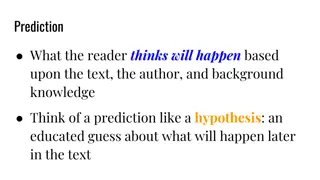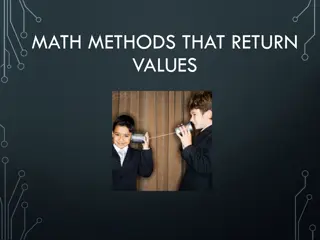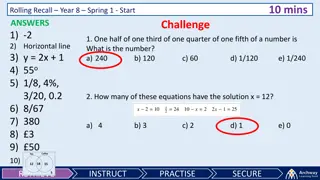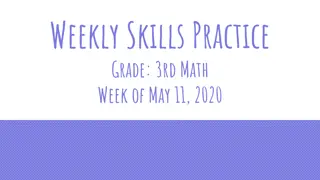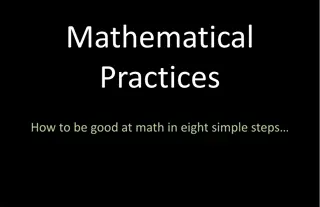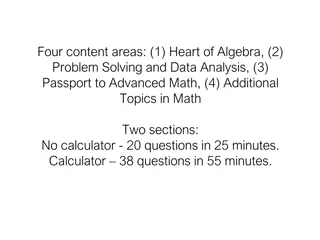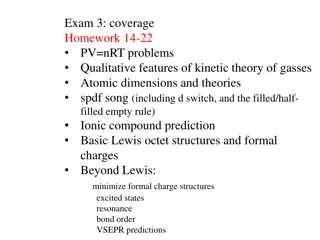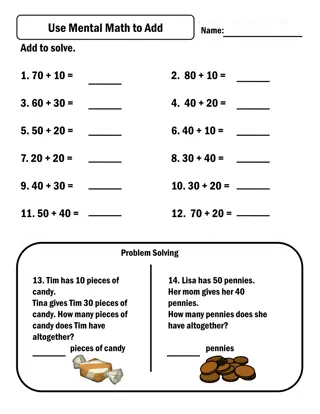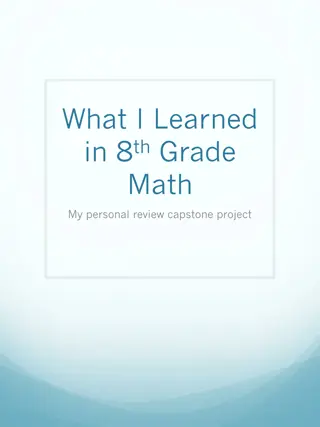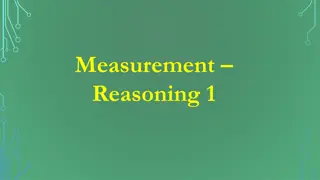Solving Math Problems and Making Predictions
Explore techniques to solve math problems involving fractions, areas of flowerbeds, and predictions based on data tables. Discover efficient ways to tackle mathematical challenges while enhancing problem-solving skills. Dive into visual representations and step-by-step solutions to sharpen your math abilities.
Download Presentation

Please find below an Image/Link to download the presentation.
The content on the website is provided AS IS for your information and personal use only. It may not be sold, licensed, or shared on other websites without obtaining consent from the author. Download presentation by click this link. If you encounter any issues during the download, it is possible that the publisher has removed the file from their server.
E N D
Presentation Transcript
While working in class, Stephanie had to do the problem 3/5 x 6/7. She started to draw rectangles to solve the problem. Is there an easier way to solve this? What information does multiplying 5 7 tell you about the model? What information does multiplying 3 6 tell you about the model?
Ronna is making a small flowerbed that is 3 feet by 1 feet. She needs to find the area so she can add the correct amount of fertilizer to the soil. Copy the diagram down. a. Write the area in each of the four parts of the diagram. b. Write an equation that represents the sum of the four areas. c. What multiplication problem could we use to solve this problem
Using the process shown in the previous problem, find the area of Ronna s flowerbed if the dimensions are 1 feet by 5 1/3 feet. Clearly label all dimensions. Write the multiplication problem that can be used to solve this problem.
Use the steps at the right to solve the following problems. 3 x 1 11/3 x 2 11/3 x 31/3
Solve 2 feet + 8 inches 3/8 of a day + of a day + 6 hours 12.5 meters + 14 kilometers 5 feet plus 3 yards
Work with your team to decide how Payton can use the data in the table to predict the wingspan of a bat if she knows its body length. Explain how she would do this.
Which axis represents the length of a bat? Which represents the wingspan? How can you tell? Label each axis. What is the scale on the horizontal axis? What is the scale on the vertical axis? Payton wants her data to be spread out so she can see the relationship clearly. How could she do that?
Would this make it easier or harder to see the relationship? Why?
Work with your team to decide on a scale for each axis that will make Payton s data easy to see. Then graph Payton s data properly.
Payton found more information about bats. In parts (a) and (b) below, you will use the information she found to make predictions about the bats. The common vampire bat is native to northern Mexico and Central and South America. It feeds on the blood of sleeping cows by making very small cuts into their skin and then licking the wounds. Use your graph of bat length and wingspan to predict the wingspan of the common vampire bat if it typically has a length of about 2.75 inches.
The Kittis hog-nosed bat, also called the bumblebee bat, is the world s smallest bat and also the world s smallest mammal! It lives in Thailand and Myanmar. It weighs less than a tenth of an ounce (less than a penny) and is only about one inch long! Make a prediction for the wingspan of the Kitti s hog-nosed bat. Be prepared to explain your thinking to the class.
Look at the graphs that your team made in this lesson and compare them to those made by other teams. Work with your team to brainstorm a complete list of information that should go on a graph to make it useful. Be sure to consider each of the questions below. What information tells you what is shown on each axis? What information tells you the exact coordinates of a point on the graph? What information tells you what the graph is about?
Andre works in his familys juice shop. He has invented the new Mathberry Madness smoothie, and word is getting around. He wants a graph showing how many new smoothies have been sold throughout the first month. He has gone through the cash-register records and gathered the data for some of the first 12 days, shown in the table at right.
He wants to graph his data and use it to predict approximately how many Mathberry Madness smoothies he can expect to sell by Day 20. He has started the graph below right. Examine Andre s graph. Can you use it to predict how many smoothies would be sold by Day 20? Why or why not? Decide how to scale the axes so that you can graph Andre s data accurately and make a prediction. Then graph it yourself.
Prediction Time! Predict how many smoothies would be sold on day 20 based on your graph.
The table at right shows the time it took five different students to get to the mall and how far they traveled to get there.
:To use the pool at the Columbus Recreation Center, guests must pay one annual membership fee and then another small fee each time they swim. Jeff and his five friends kept track of how many times they visited the pool in one year and how much money they each spent.
Jackson heard that baseball pitchers are getting taller and taller. He found the data shown in the table at right. Jackson thought a graph might help him see how the heights are changing, but he thinks that this data will be really hard to graph. Discuss this with your team. Do you agree? What, if anything, makes this data hard to graph? Explain.
Jackson has an idea! He decided to change the way he wrote the data and started the table shown below. How did Jackson figure out what numbers to put in the table? Discuss this with your team and then copy and complete the table on your own paper. -On your paper, graph Jackson s data. Be sure to choose an appropriate scale and label the axes so that it is a complete graph. -Help Jackson predict how tall pitchers might be on average in the year 2020.



